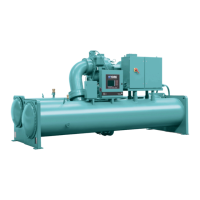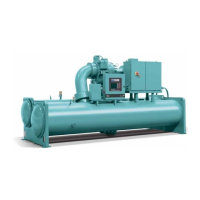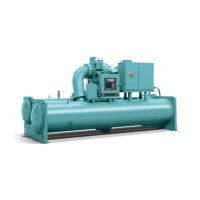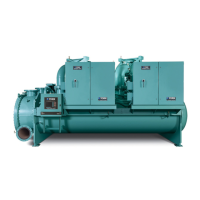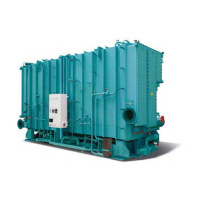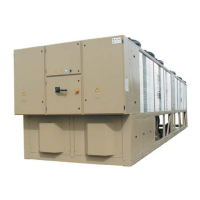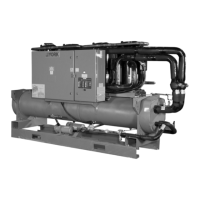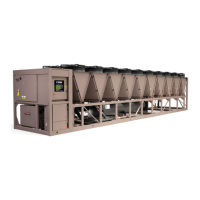FORM 160.77-O2
ISSUE DATE: 11/15/2011
SECTION 5 - DISPLAY MESSAGES
JOHNSON CONTROLS
115
5
Oil Sump Pressure Out of Range
The Oil Sump Pressure Transducer is indicating a pres-
sure that is less than 0.0PSIG, or greater than 300.0
PSIG. This is outside the normal operating range of
the transducer. This is generally indicates a defective
transducer. The chiller can be started after the trans-
ducer is indicating a pressure that is within range.
Primary Oil Pump Pressure Out of Range
The Primary Oil Pump Pressure Transducer is indi-
cating a pressure that is less than 0.0 PSIG, or greater
than 300.0 PSIG. This is outside the normal operating
range of the transducer. This is generally indicates a
defective transducer. The chiller can be started after the
transducer is indicating a pressure that is within range.
Secondary Oil Pump Pressure Out of Range
The Secondary Oil Pump Pressure Transducer is indi-
cating a pressure that is less than 0.0 PSIG, or greater
than 300.0 PSIG. This is outside the normal operating
range of the transducer. This is generally indicates a
defective transducer. The chiller can be started after the
transducer is indicating a pressure that is within range.
Primary Stall Sensor Out of Range
The Primary Stall Sensor is indicating a voltage that
is less than 0.5 V, or greater than 4.5 V. This is outside
the normal operating range of the stall sensor. This is
generally indicates a defective sensor.
Primary Stall Sensor High
This message is generated when there is a warning of
an impending trip of 100 PSIG.
Primary Stall Sensor Very High
The Primary Stall Sensor has exceeded 200 PSIG.
Secondary Stall Sensor Out of Range
The Primary Stall Sensor is indicating a voltage that
is less than 0.5 V, or greater than 4.5 V. This is outside
the normal operating range of the stall sensor. This is
generally indicates a defective sensor.
Secondary Stall Sensor High
This message is generated when there is a warning of
an impending trip of 180 PSIG.
Secondary Stall Sensor Very High
The Secondary Stall Sensor has exceeded 200 PSIG.
Primary PRV Position Out of Range
The Primary PRV Position Sensor is indicating a volt-
age that is less than 0 V, or greater than 4.5 V. This is
outside the normal operating range of the position sen-
sor. This is generally indicates a miscalibrated sensor,
loose or shorted wiring.
Secondary PRV Position Out of Range
The Secondary PRV Position Sensor is indicating a
voltage that is less than 0 V, or greater than 5 V. This is
outside the normal operating range of the position sen-
sor. This is generally indicates a miscalibrated sensor,
loose or shorted wiring.
Primary Thrust Prox Probe Out of Range
The Primary Thrust Prox Probe is indicating a voltage
that is less than 0.4 V, or greater than 4.4 V. This is
outside the normal operating range of the Proximity
Probe. This is generally indicates a defective probe, or
a poor connection on the coaxial cable betweeen the
probe and the transmitter.
Primary Thrust Prox Probe Very Low
This message is generated when the Primary Thrust
Prox Probe is less than 19 mils. Requires a login ac-
cess level of Service to recalibrate. Qualified service
technicians refer to YKEP control panel service manu-
al 160.77-M2 for further explanation and recalibration
procedure instructions.
Primary Thrust Prox Probe Very High
The Primary Thrust Prox Probe has exceeded 99 mils.
Requires a login access level of Service to recalibrate.
Qualified service technicians refer to YKEP control
panel service manual 160.77-M2 for further explana-
tion and recalibration procedure instructions.
Primary VGD Position Out of Range
The Primary VGD Position Sensor is indicating a volt-
age that is less than 0 V, or greater than 5 V. This is out-
side the normal operating range of the VGD Position
Sensor. This is generally indicates a defective sensor.
Secondary VGD Position Out of Range
The Secondary VGD Position Sensor is indicating a
voltage that is less than 0 V, or greater than 5 V. This is
outside the normal operating range of the VGD Posi-
tion Sensor. This is generally indicates a defective sen-
sor.
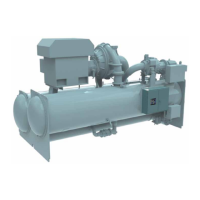
